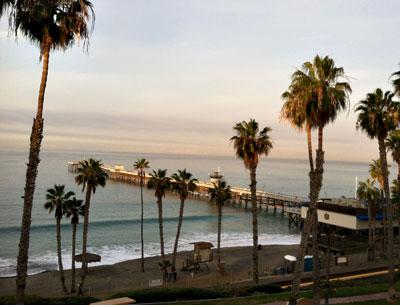Short Walk on a Long Pier

“Go take a long walk off a short pier.” Not sure why the dismissive phrase came to mind. The pier at San Clemente was not short by a long shot, 200 yards or more. I think it’s because in our minds, piers are a staple, a construct that everyone understands.
“Why do they build them? Just to fish from? Are they for people without boats?” Kyle asked. Good question, and the answer is pretty much, yes, but more. The Pier, as societal microcosm, parade, and oceangoing adventure for pedestrians, has been perfected in California.
Young women with sleeves of tattoos pushed baby carriages, two tittering Japanese tourists whipped out iPhones to photograph a seven-foot-tall man as he passed, a clutch of fishermen at the pier’s end worked multiple rods and live-bait nets with halibut on their minds, their lines 40 down to the sea surface. One with a scarred head and a T-shirt representing his Marine Corps unit reminded us that Camp Pendleton was nearby. Over the side next to the pier’s pilings, surfers waited for Coke-bottle blue-green waves. At its shoreward end, a restaurant offered happy-hour margaritas, calamari, steaks, and Dungeness crabs. Amtrak’s Shoreliner whistled south, Pelicans cruised the 80-degree air.
At its core, a pier is a place built especially for people without boats who are drawn to the sea, a structure whose purpose is deemed important enough to spend big bucks to maintain it. Montauk has a beauty with its own subculture that the town maintains in Fort Pond Bay.
There once was a fishing pier that jutted out from the beach in front of the Montauk Lighthouse and was repaired each summer after winter storms did their worst. Can you imagine watching bluefish and striped bass passing under the pier, boiling at your feet?
The trip to California was a success. I was able to tour the Surfing Heritage Foundation Museum and enlist its help in the creation of the Montauk Lighthouse Museum’s Oceans Institute. I caught some waves at “San-O,” San Onofre, generated from a storm off Japan. The waves were perked up by Santa Ana winds that carried the occasional burst of 50-caliber machine-gun fire from Pendleton nearby.
We drove the four-lane, 80-mile-per-hour winding anaconda that’s the freeway known as the Five, and the good ole coast highway with its ’50s-style, slant-roofed burger joints, chopped pickups, and ape-hangered Harleys. A pier is built for people drawn to the sea. Or, is it for people escaping each other. Is there a difference?
On the beach beside the pier were strewn clumps of deep-yellow kelp. Small, plover-like pipers minced, and there was bigger shorebird called a whimbrel of the curlew family. A hippy chick in an altered state with arms spread embraced the sea, yoga posed, embraced the sky, drew a circle in the sand with a peace sign at its center, wrote around the inside of the circle’s border, “Only love can save us from ourselves.” And, I’m thinking, perhaps a pier.
